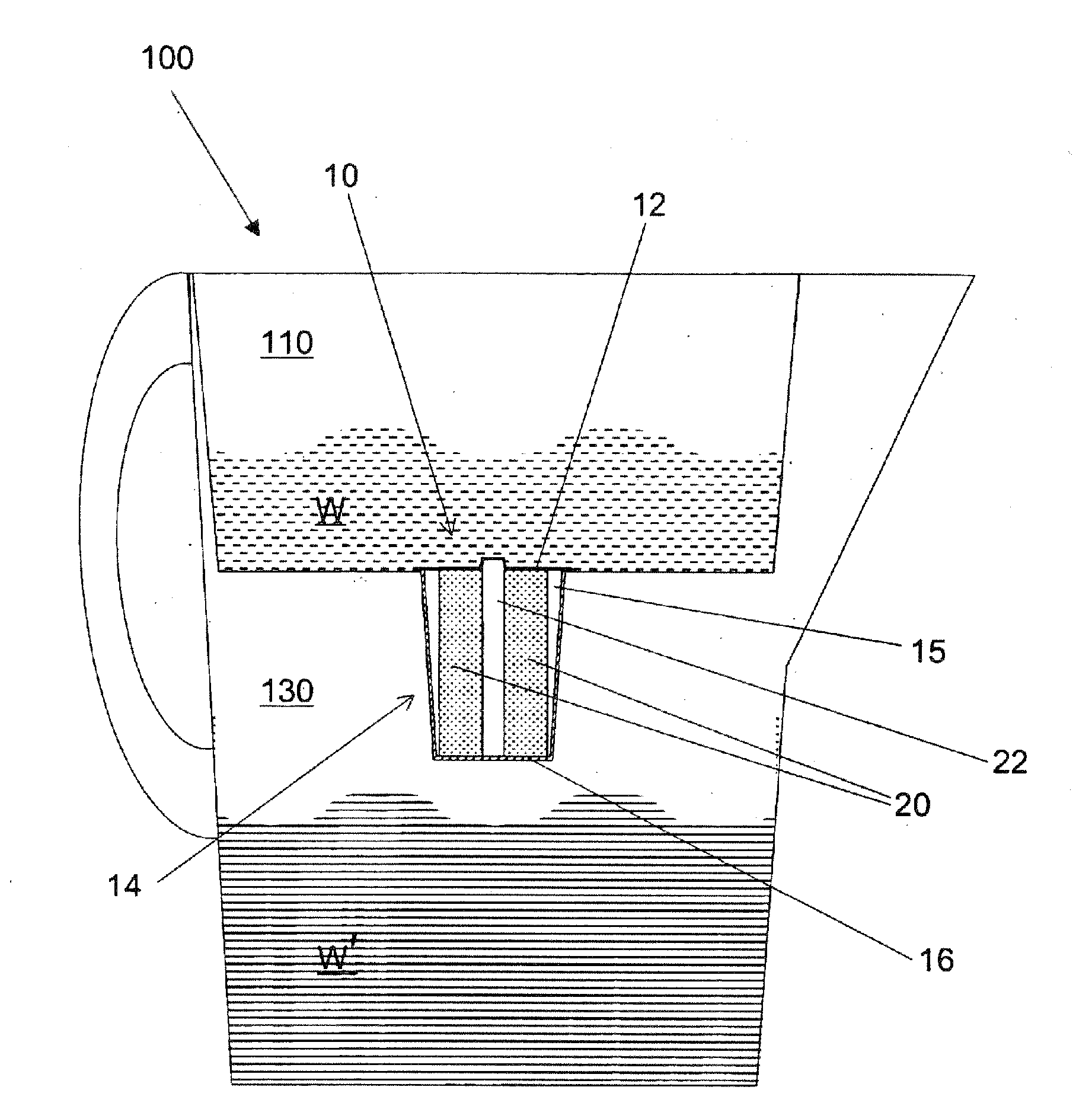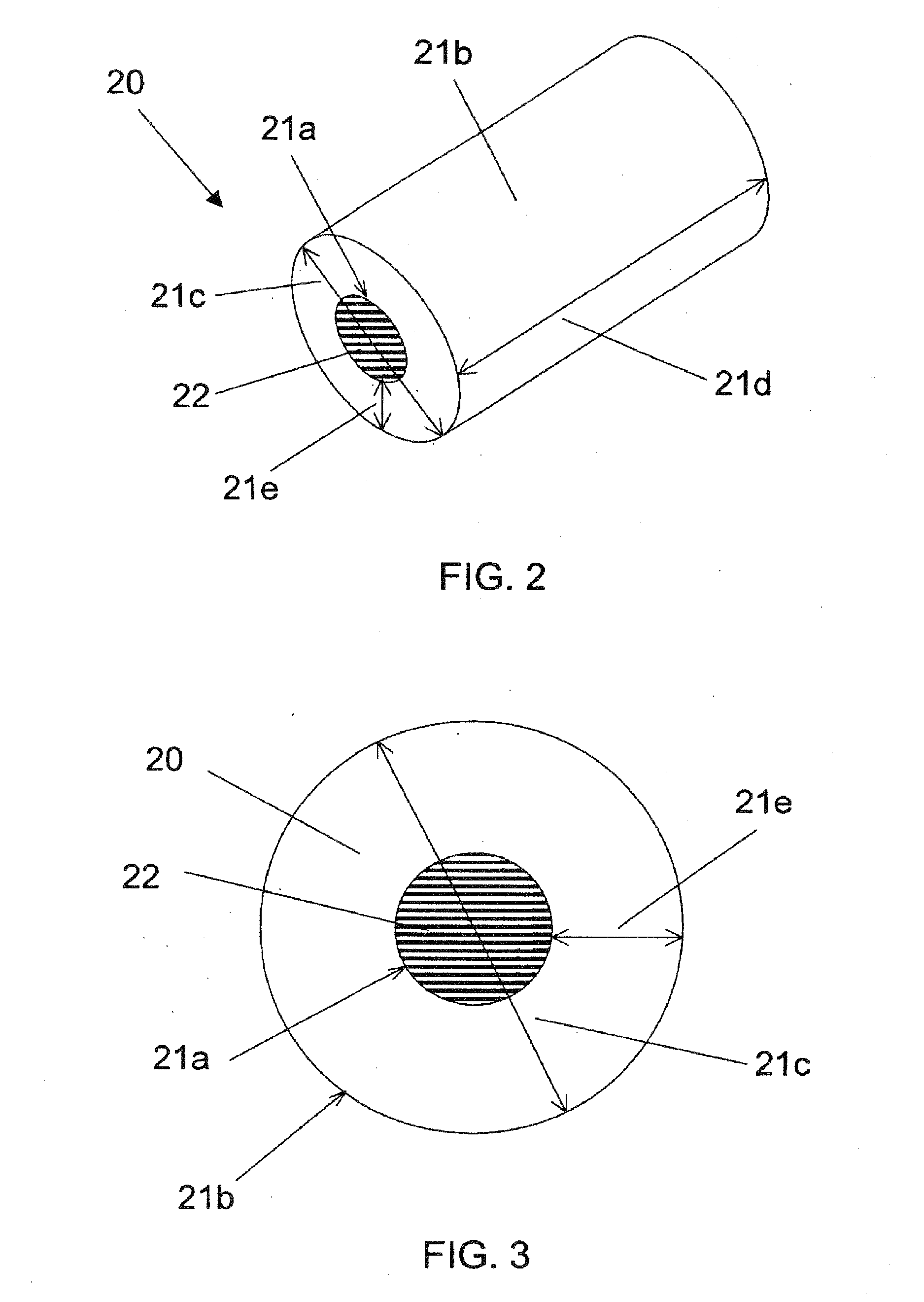Gravity Flow Carbon Block Filter
a carbon block filter and gravity flow technology, applied in the direction of filtration separation, multi-stage water/sewage treatment, separation process, etc., can solve the problems of limiting the flow rate, and failing to produce the desired flow rate consistently
- Summary
- Abstract
- Description
- Claims
- Application Information
AI Technical Summary
Benefits of technology
Problems solved by technology
Method used
Image
Examples
example 1
[0139]Two carbon block filters comprising approximately 80 wt % 80×200 mesh activated carbon (i.e., coconut shell carbon) and approximately 20 wt % binder were formed to investigate the water absorption characteristics of different binders. In filter #1, the binder was EVA. In filter #2, the binder was VHMWPE.
[0140]The degree to which carbon was available in each case to absorb impurities is indicated in the column labeled “percent available carbon.” This was determined by comparing the iodine number for the raw carbon to the iodine number for the bound carbon.
[0141]As will be appreciated by one having skill in the art, the iodine number is a number expressing the quantity of iodine absorbed by a substance. Referring now the Table I, the fourth column expresses the iodine number for the raw carbon. The fifth column expresses the iodine number for the carbon in its bound form, i.e., in a filter block. In each case, the filter block was first produced in accordance with the process de...
example 2
[0144]As is well known, a common measure of the absorbency of a material is called the “strike-through” value. The “strike-through” values are commonly employed in the absorbent article industry (e.g. diapers) to determine how fast a material absorbs water. Strike-through values were thus employed in the instant example to quantify the “wettability” of the carbon block filters. The method employed was as follows: a 1.0 in. internal diameter pipe section was glued to the surfaces of several carbon block filters so that approximately 0.785 in2 of the block surface was exposed in the bottom of the pipe. A set quantity of water (i.e., 5.0 ml) was then introduced rapidly into the pipe section. Simultaneously with the introduction of the water, a timer was started. When the carbon block absorbed all the water, the timer was stopped and the absorption time recorded. The time to absorb the 5.0 ml of water was deemed the “strike-through” value for the respective carbon block filter.
[0145]Ref...
example 3
[0150]The porosity of the carbon block filter is also critical in the performance and flow rate of the carbon block filters. The porosity of the finished carbon block is determined mainly by the particle sizes of the raw materials and by the amount of compression exerted on the block during the manufacturing process. As discussed below, smaller particles and higher compression can each result in lower porosity.
[0151]In order to investigate the porosity of the carbon block filters, carbon block filters of approximately 65 wt % activated carbon, 20 wt % EVA or VHMWPE binders and 15 wt % zeolite were prepared in accordance with procedures described herein.
[0152]Referring to Table III, porosity data for the noted filters are shown. The median pore diameter was determined by mercury porosimetry.
TABLE IIIVol. MedianFilterPore Dia.Flow RateFilter Ref.CarbonBinderZeoliteComp.(μm)(liter / min) #9~65 wt %~20 wt %~15 wt %20%45.390.680 × 200EVAmesh#10~65 wt %~20 wt %~15 wt %20%12.040.1380 × 325EV...
PUM
| Property | Measurement | Unit |
|---|---|---|
| Temperature | aaaaa | aaaaa |
| Weight | aaaaa | aaaaa |
| Length | aaaaa | aaaaa |
Abstract
Description
Claims
Application Information
 Login to View More
Login to View More - R&D
- Intellectual Property
- Life Sciences
- Materials
- Tech Scout
- Unparalleled Data Quality
- Higher Quality Content
- 60% Fewer Hallucinations
Browse by: Latest US Patents, China's latest patents, Technical Efficacy Thesaurus, Application Domain, Technology Topic, Popular Technical Reports.
© 2025 PatSnap. All rights reserved.Legal|Privacy policy|Modern Slavery Act Transparency Statement|Sitemap|About US| Contact US: help@patsnap.com



